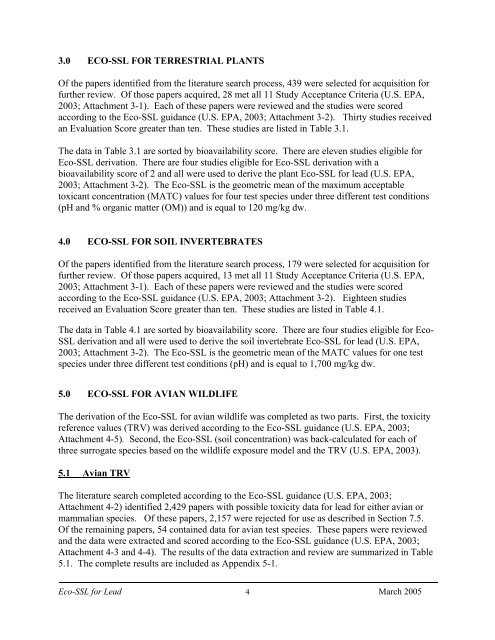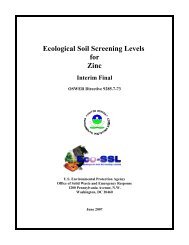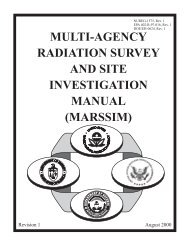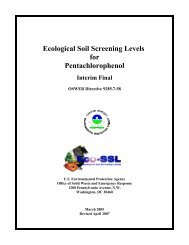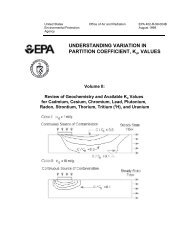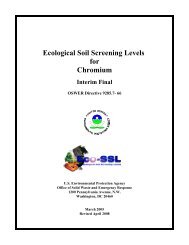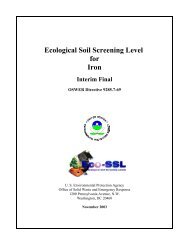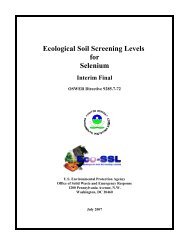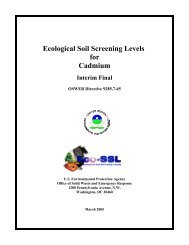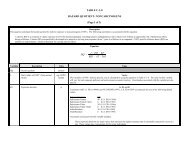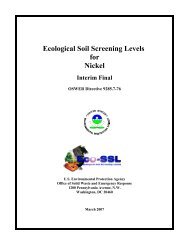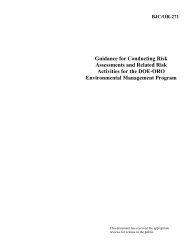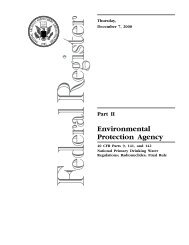C:\Eco-SSLs\Contaminant Specific Documents\Lead\November ...
C:\Eco-SSLs\Contaminant Specific Documents\Lead\November ...
C:\Eco-SSLs\Contaminant Specific Documents\Lead\November ...
You also want an ePaper? Increase the reach of your titles
YUMPU automatically turns print PDFs into web optimized ePapers that Google loves.
3.0 ECO-SSL FOR TERRESTRIAL PLANTS<br />
Of the papers identified from the literature search process, 439 were selected for acquisition for<br />
further review. Of those papers acquired, 28 met all 11 Study Acceptance Criteria (U.S. EPA,<br />
2003; Attachment 3-1). Each of these papers were reviewed and the studies were scored<br />
according to the Eco-SSL guidance (U.S. EPA, 2003; Attachment 3-2). Thirty studies received<br />
an Evaluation Score greater than ten. These studies are listed in Table 3.1.<br />
The data in Table 3.1 are sorted by bioavailability score. There are eleven studies eligible for<br />
Eco-SSL derivation. There are four studies eligible for Eco-SSL derivation with a<br />
bioavailability score of 2 and all were used to derive the plant Eco-SSL for lead (U.S. EPA,<br />
2003; Attachment 3-2). The Eco-SSL is the geometric mean of the maximum acceptable<br />
toxicant concentration (MATC) values for four test species under three different test conditions<br />
(pH and % organic matter (OM)) and is equal to 120 mg/kg dw.<br />
4.0 ECO-SSL FOR SOIL INVERTEBRATES<br />
Of the papers identified from the literature search process, 179 were selected for acquisition for<br />
further review. Of those papers acquired, 13 met all 11 Study Acceptance Criteria (U.S. EPA,<br />
2003; Attachment 3-1). Each of these papers were reviewed and the studies were scored<br />
according to the Eco-SSL guidance (U.S. EPA, 2003; Attachment 3-2). Eighteen studies<br />
received an Evaluation Score greater than ten. These studies are listed in Table 4.1.<br />
The data in Table 4.1 are sorted by bioavailability score. There are four studies eligible for Eco-<br />
SSL derivation and all were used to derive the soil invertebrate Eco-SSL for lead (U.S. EPA,<br />
2003; Attachment 3-2). The Eco-SSL is the geometric mean of the MATC values for one test<br />
species under three different test conditions (pH) and is equal to 1,700 mg/kg dw.<br />
5.0 ECO-SSL FOR AVIAN WILDLIFE<br />
The derivation of the Eco-SSL for avian wildlife was completed as two parts. First, the toxicity<br />
reference values (TRV) was derived according to the Eco-SSL guidance (U.S. EPA, 2003;<br />
Attachment 4-5). Second, the Eco-SSL (soil concentration) was back-calculated for each of<br />
three surrogate species based on the wildlife exposure model and the TRV (U.S. EPA, 2003).<br />
5.1 Avian TRV<br />
The literature search completed according to the Eco-SSL guidance (U.S. EPA, 2003;<br />
Attachment 4-2) identified 2,429 papers with possible toxicity data for lead for either avian or<br />
mammalian species. Of these papers, 2,157 were rejected for use as described in Section 7.5.<br />
Of the remaining papers, 54 contained data for avian test species. These papers were reviewed<br />
and the data were extracted and scored according to the Eco-SSL guidance (U.S. EPA, 2003;<br />
Attachment 4-3 and 4-4). The results of the data extraction and review are summarized in Table<br />
5.1. The complete results are included as Appendix 5-1.<br />
Eco-SSL for Lead 4<br />
March 2005


